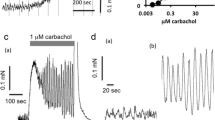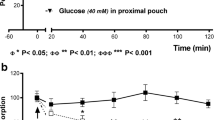Summary
Guinea-pig common bile duct preparations were used to quantify the spasmolytic potency of N-butylscopolamine (NBS), papaverine, gallopamil and nifedipine. A method was developed which allowed the measurement of intraluminal pressure changes in vitro. Barium chloride, carbachol and a solution with elevated potassium concentrations were used to stimulate smooth muscles. Concentration-response relationships for the spasmogens as well as for the spasmolytic drugs were evaluated in a cumulative manner. Furthermore, noncumulative concentration-response curves were constructed for carbachol in the absence and presence of NBS.
The -log EC50-values of the spasmogens were found to be 3.28±0.08 (BaCl2), 6,46±0.07 (carbachol) and 1.31±0.08 (KCI), respectively. The Emax values of carbachol and potassium were comparable, and were twice as high as the Emax of BaCl2. Papaverine was less potent than the calcium antagonists gallopamil and nifedipine, but proved capable of completely suppressing elevated muscular tone of the common bile duct preparation, independent of the stimulus used. NBS showed a high potency in suppressing only a carbachol-induced pressure increase, while it was rather ineffective when BaCl2 or a high potassium solution was used as the spasmogen. The concentration-response-curve for carbachol was shifted to the right in a parallel manner by NBS. Only a slight depression of Emax was observed.
From the results it is concluded that NBS acts mainly as a muscarinic receptor antagonist. The high potency found for the calcium antagonists, gallopamil and nifedipine, in this model may indicate a possible role for these compounds in the treatment of biliary colic.
Similar content being viewed by others
References
Ariëns EJ (1964) Molecular pharmacology: The mode of action of biologically active compounds. In: De Stevens G (ed) Medicinal chemistry, Vol 3. Academic Press, New York London, pp 119–269
Bolck F (1960) Extrahepatische Gallenwege and Gallenblase. In: Buchner F, Letterer E, Roulet F (eds) Handbuch der allgemeinen Pathologie, Vol 3, pp 304-36
Brandstaetter G (1983) Pharmacological pressure reduction in the human common bile duct. Z Gastroenterol 21:168–174
Bromzon A, Finberg JP, Tovbin D, Naidu SG, Better OS (1984) Bile salts, hypotension and obstructive jaundice. Clin Sci 67:177–183
Bülbring E, Crema A, Saxby OB (1958) A method for recording peristalsis in isolated intestine. Br J Pharmacol 13:440–443
Cai W-Q, Gabella G (1983) Innervation of the gallbladder and biliary pathways in the guinea-pig. J Anat 136:97–109
Dahl-Iversen E, Sorensen AH and Westengaard E (1958) Pressure measurement in the biliary tract in patients after cholecystolithotomy and in patients with dyskinesia. Acta Chir scand 114:181–190
Jacobsson B (1957) Detremination of pressure in the common bile duct at and after operation. Acta Chir Scand 113:483–488
Kamikawa Y, Shimo Y (1987) Different spasmolytic effect of smooth muscle relaxants on the guinea-pig esophageal muscularis mucosae contracted by carbachol or high potassium in vitro. Eur J Pharmacol 136:39–48
Mathie RT, Plail RO, Stubbs RS (1987) Pressure changes in canine gallbladder associated with emptying. J Physiol (Lond) 393:545–554
Nayler WG (1988) Ion conducting channels: calcium. In: Nayler WG (ed) Calcium antagonists. Academic Press, London New York, pp 23–44
Pallin B, Skoglund S (1961) On the nervous regulation of the biliary system in cat. Acta Physiol Scand 51:187–192
Pöch G, Umfahrer W (1976) Differentiation of intestinal smooth muscle relaxation caused by drugs that inhibit phosphodiesterase. Naunyn-Schmiedeberg's Arch Pharmacol 293:257
Sagrada A, Schiavone A, Cefala A, Trespi P, Giachetti A (1987) N-butyl hyoscine exerts local spasmolytic effect in the small and large bowl of the conscious dog. Arch Int Pharmacodyn Ther 287:237–247
Sunagane N, Ogawa T, Uruno T, Kubota K (1985) Mechanism of relaxant action of papaverine VI. Sodium ion dependence of its effect on 45Ca-efflux in guinea-pig taenia coli. Japan J Pharmacol 38:133–139
Sunagane N, Kobori T, Uruno T, Kubota K (1986) Mechanisms of spasmolytic action of bile salts in depolarized guinea-pig taenia coli: J Pharmacobiodyn 9:473–478
Troebs RB, Mahnke PF (1988) Morphologic studies of the extrahepatic bile ducts in infancy, childhood and youth. Anat Anz 167:301–312
Westphal K (1923) Muskelfunktion, Nervensystem and Pathologie der Gallenwege. Z Klin Med 96:22–150
Yamasato T, Nakayama S (1988) Effects of neurotensin on the motility of the isolated gallbladder, bile duct and ampulla in guinea-pigs. Eur J Pharmacol 148:101–106
Author information
Authors and Affiliations
Additional information
Send offprint requests to M. Pfaffendorf at the above address
Rights and permissions
About this article
Cite this article
Pfaffendorf, M., Moormann, M. & Sponholz, F. Comparison of various spasmolytic drugs on guinea-pig isolated common bile duct. Naunyn-Schmiedeberg's Arch Pharmacol 344, 114–118 (1991). https://doi.org/10.1007/BF00167390
Received:
Accepted:
Issue Date:
DOI: https://doi.org/10.1007/BF00167390




